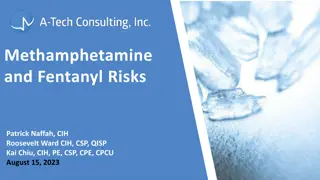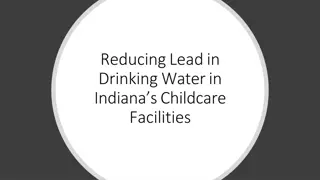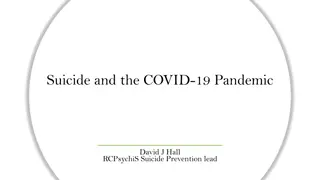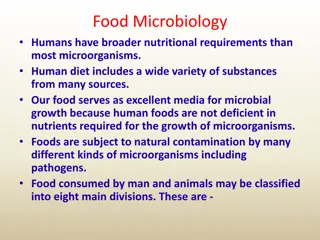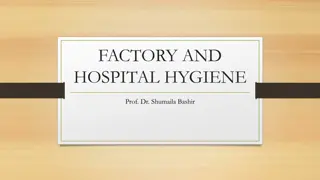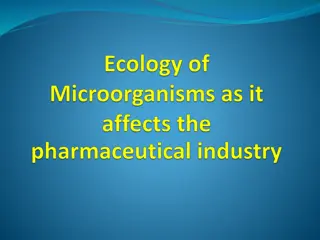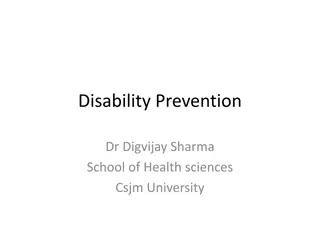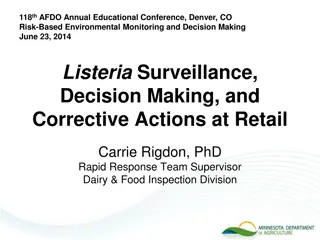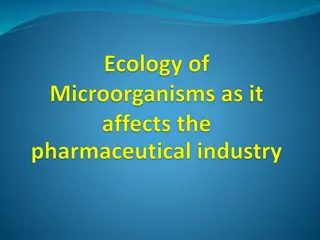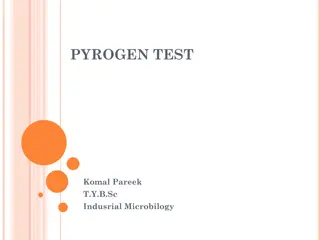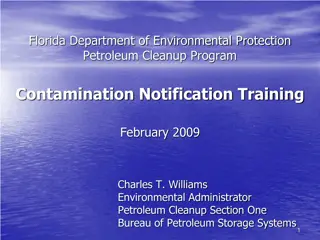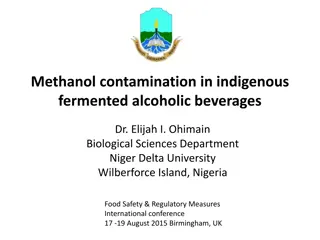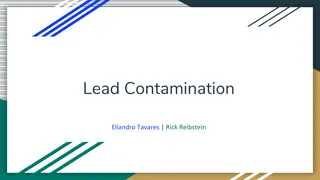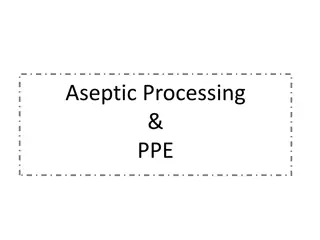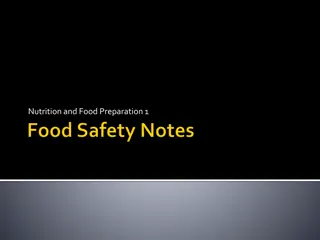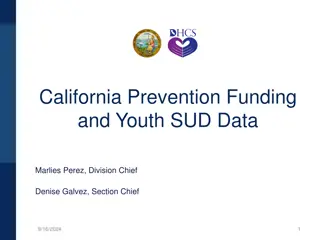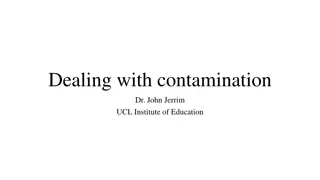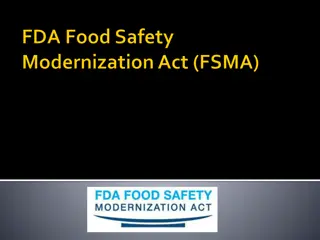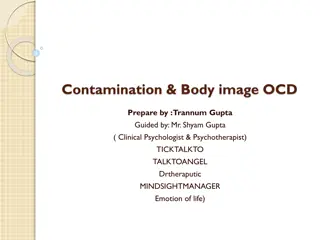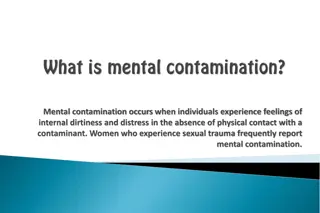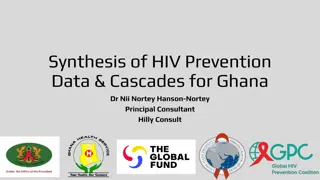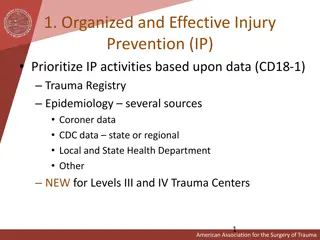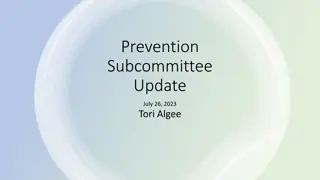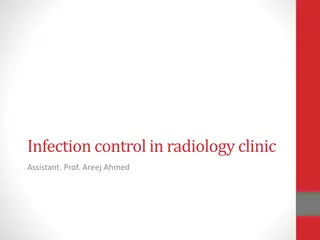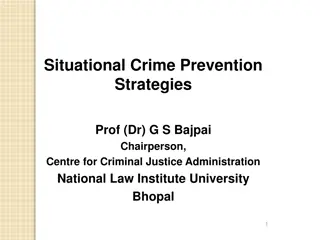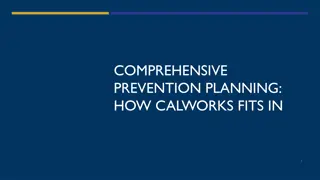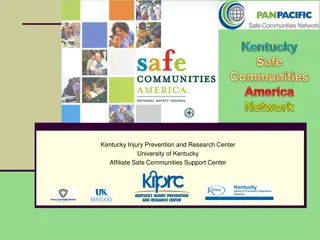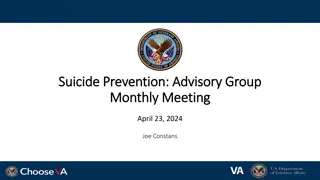Understanding the Economic and Health Impacts of Groundwater Nitrate Contamination in Nebraska
The economic and health costs of groundwater nitrate contamination in Nebraska highlight the challenges of ensuring safe drinking water. Despite largely safe levels, proactive strategies are essential due to rising nitrate levels and costly maintenance efforts. The compliance record shows progress i
0 views • 18 slides
Understanding Risks and Impacts of Methamphetamine and Fentanyl Contamination
Explore the high risks associated with Methamphetamine and Fentanyl contamination, including the severity and frequency factors. Learn about the environmental exposure routes, consequences for occupants, trends, costs, remediation processes, and more.
0 views • 15 slides
Understanding the Impact of Lead Contamination on Human Health and Ecosystems
Exploring the detrimental effects of lead exposure on human health and the environment, this content touches on lead contamination in drinking water, its effects on various bodily systems, and its impact on ecosystems. It also delves into the history of lead usage, major contributors to lead polluti
0 views • 18 slides
Progress in Prevention and Health Inequalities - Annual Report 2023-24
The Prevention and Health Inequalities Team at BOB ICB is dedicated to enhancing prevention efforts and reducing health inequalities across their population and communities. Key achievements include setting up inpatient and maternity tobacco dependency treatment services, establishing prevention net
0 views • 14 slides
Understanding Suicide Risk and Prevention During the COVID-19 Pandemic
The COVID-19 pandemic has raised concerns about potential increases in suicide rates due to its economic impacts and social disruptions. While there is a focus on suicide prevention efforts, the exact effect of the pandemic on suicide rates remains unclear. Initiatives such as Suicide Prevention Act
1 views • 10 slides
Understanding Food Microbiology: Sources of Contamination
Humans have broader nutritional requirements than most microorganisms. The human diet includes a wide variety of substances, making our food excellent media for microbial growth. Natural contamination of food by various microorganisms, including pathogens, is common. Food consumed by humans and anim
0 views • 51 slides
Guidelines for Maintaining Hygiene in Manufacturing Environments
The article highlights the importance of hygiene in both manufacturing industries and hospitals, covering key aspects such as manufacturing processes, quality assurance, good manufacturing practices, quality control, and microbial contamination control. Environmental cleanliness and hygiene play a c
0 views • 21 slides
Importance of Meat Hygiene and Sanitation in the Meat Industry
Meat hygiene is essential to ensure the safety and suitability of meat for consumers. It involves implementing specific standards and regulatory actions to maintain cleanliness and prevent contamination at all stages of production. Proper cleaning and sanitization practices, adherence to legal stand
0 views • 16 slides
Microbiological Quality Control in Pharmaceutical Environment
Microbiological products in pharmaceutical settings are influenced by the quality of materials and the environment. Good Manufacturing Practices (GMP) are essential to minimize contamination risks, with control points focused on the ecology of microorganisms. Sources of contamination include the atm
1 views • 128 slides
Understanding Disability Prevention and Levels of Prevention
Disability prevention involves efforts to eliminate or reduce the causes and severity of disabilities. It can be achieved through primary, secondary, and tertiary prevention strategies, aiming to prevent risk factors that cause impairment and promote overall well-being. Primary prevention focuses on
2 views • 21 slides
Safeguarding Your Kitchen: Preventing Cross-Contamination
Cross-contamination poses a risk of foodborne illnesses and can occur in multiple ways, such as using the same utensils for raw and cooked foods. Taking specific cleaning steps at home, like regularly cleaning dish cloths and sanitizing surfaces, is vital to preventing harmful bacteria from spreadin
0 views • 8 slides
Risk-Based Environmental Monitoring for Listeria Surveillance at Retail
Explore the importance of risk-based environmental monitoring and decision-making in detecting Listeria contamination in retail food settings. Learn about routine sampling plans, trends in positive samples, species distribution, and key locations of Listeria findings from 2010 to 2014. Discover why
1 views • 12 slides
Managing Microbiological Quality in Pharmaceutical Environments
The quality of microbiological products is influenced by the pharmaceutical environment materials. Good Manufacturing Practices (GMP) play a crucial role in minimizing contamination risks. Various sources of contamination include the atmosphere, water, persons, raw materials, packaging, buildings, a
0 views • 128 slides
Understanding Pyrogen Testing in Pharmaceutical Production
Pyrogen testing is crucial in ensuring pharmaceutical safety by detecting bacterial toxins that may cause fever in humans. Methods such as the rabbit pyrogen test and human response to pyrogens illustrate the importance of quality control measures in production to prevent contamination. By identifyi
0 views • 8 slides
Contamination Notification Training: Florida Department of Environmental Protection
This document outlines the Contamination Notification Training provided by the Florida Department of Environmental Protection in February 2009. It covers types of contamination notification, governing statutes, rules, and guidance, specific noticing requirements, and changes from prior guidance. The
0 views • 25 slides
Comprehensive Student Support Program for Mental Health and Wellness
Providing a wide range of no-cost services to students and families, the program focuses on drug/alcohol prevention, suicide prevention, character building, bullying prevention, and more. Through initiatives like teaching Botvin Life Skills, implementing suicide prevention curriculum, and offering s
1 views • 5 slides
Methanol Contamination in Indigenous Fermented Alcoholic Beverages: Impacts and Regulatory Measures
Indigenous fermented alcoholic beverages are facing methanol contamination issues, leading to severe health consequences and fatalities worldwide. This article highlights the concerning incidences of methanol poisoning, symptoms, and regulatory limits in various countries. The informal production of
13 views • 27 slides
Addressing Lead Contamination: Advocating for Effective Legislation
Working towards effective lead contamination legislation involves setting clear goals, engaging with experts and legislators, expanding testing and awareness efforts, and ensuring existing laws are enforced. Key figures like Senators Chang-Diaz and Eldridge are involved, along with advocacy at event
3 views • 6 slides
Understanding Aseptic Processing and Contamination Control in Cleanroom Environments
Aseptic processing involves maintaining a sterile environment to prevent contamination in cleanroom settings. The presence of non-viable and viable particulate contamination, such as dust and live microorganisms, poses challenges. Sources of contamination include equipment, structures, surfaces, and
0 views • 29 slides
POLLUTION PREVENTION: A Closer Look at Environmental Initiatives in Oklahoma
Explore the evolution and implementation of pollution prevention measures in Oklahoma, focusing on statutory directives, recent activities, recycling efforts, tax credits, and more. The Pollution Prevention Act of 1990 plays a crucial role in reducing environmental hazards through the reduction of p
0 views • 31 slides
Food Safety and Prevention of Food-borne Illnesses
An estimated 48 million Americans suffer from food-borne illnesses yearly, caused by harmful microorganisms due to poor food handling practices. Factors contributing to food-borne illnesses include improper cooking, inadequate storage, and cross-contamination. To prevent such illnesses, it is essent
0 views • 23 slides
Prevention and Care of Airborne Infections in TB/HIV Settings
In this session, participants will learn the importance of infection prevention and control in TB/HIV care, levels of prevention in airborne infections, strategies to prevent TB transmission in healthcare settings, and patient management steps to prevent TB transmission. The spread of TB, risks of t
0 views • 20 slides
Youth Substance Abuse Prevention Funding in California
California utilizes Substance Abuse Prevention and Treatment Block Grant (SABG) funding to support primary prevention services for youth. Approximately $40 million is distributed annually to 58 counties for strategic prevention planning based on local needs assessments. Initiatives like the Strategi
0 views • 18 slides
Understanding Contamination in Research Studies
Understand the concept of contamination in research studies, its impact on the effectiveness of Randomized Controlled Trials (RCTs), and different analysis methods to handle contamination, such as Intention-to-Treat (ITT) and Contamination-Adjusted Intention-to-Treat (CA-ITT) analyses. Learn how to
0 views • 40 slides
Guidelines for Animal Disposal Methods
Environmental and biosecurity guidelines recommend various disposal methods such as composting, rendering, permitted landfill, unlined burial, fixed-facility incineration, and open-air burning. Each method has specific selection criteria and considerations to minimize risks to the environment and bi
0 views • 17 slides
Agricultural Water Safety Regulations Overview
The final Produce Rule and Preventive Controls Rule, effective since November 13, 2015, set criteria for microbial contamination in agricultural water. Generic E. coli levels are key indicators, affecting water uses in post-harvest and production. Criteria like Geometric Mean and Statistical Thresho
0 views • 43 slides
Understanding Contamination OCD: Symptoms, Obsessions, and Misconceptions
Contamination OCD is a subset of OCD characterized by severe fears of becoming contaminated by germs or getting sick. Individuals with this condition may exhibit compulsions such as avoidance, excessive washing, and health testing. It's crucial to differentiate between normal intrusive thoughts and
0 views • 21 slides
Understanding Mental Contamination: Causes and Effects
Mental contamination is a phenomenon where individuals experience feelings of internal dirtiness and distress without physical contact with a contaminant. It is common among women who have experienced sexual trauma. Symptoms include fear of imagined contaminants, ritualistic acts to neutralize them,
0 views • 7 slides
Comprehensive Overview of HIV Prevention Strategies and Interventions
This synthesis covers the importance of monitoring progress in HIV prevention through data cascades, the need for standardized frameworks, promoting effective HIV prevention programs in diverse social contexts, and the key pillars of combination HIV prevention strategies. It also outlines various HI
0 views • 40 slides
Food Safety and Cross-Contamination Prevention Guidelines
Understanding the flow of food is crucial in preventing cross-contamination at various stages of food handling. This chapter delves into key terms, temperature-measuring devices, calibration methods, and guidelines to prevent cross-contamination. By implementing separate equipment, proper cleaning,
0 views • 23 slides
Best Practices for Contamination Control in Pharmaceutical Manufacturing
Implementing a robust Contamination Control Strategy (CCS) as part of the Pharmaceutical Quality System is crucial for ensuring product quality and safety. The strategy encompasses various elements like process risk management, preventative maintenance, and personnel training. Manufacturers must foc
0 views • 19 slides
Effective Strategies for Injury Prevention in Trauma Centers
Organized and data-driven injury prevention activities are crucial in trauma centers. Community partnerships, evidence-based reviews, designated injury prevention coordinators, and involvement of trauma personnel are key elements for successful injury prevention. Targeting contributing factors like
0 views • 20 slides
Prevention Subcommittee Update - July 26, 2023 Review
The Prevention Subcommittee Update held on July 26, 2023, highlighted key topics including an introduction, strategic plan prioritization, insights from subject matter experts, and discussions on the Prevention Center and workshops. The subcommittee comprises talented preventionist commissioners and
0 views • 6 slides
Assessment of HIV Prevention Programme Needs and Barriers in Ghana
Conduct a data-driven assessment of HIV prevention programme needs and barriers in Ghana based on the Ghana Road Map Baseline Survey components. Evaluate the country's preparedness in addressing HIV epidemic patterns and prevention response analysis. Identify key barriers hindering HIV prevention ef
0 views • 11 slides
Exploring Pesticide Monitoring and Contamination Studies in Maine
Mary Tomlinson's work with the Maine Board of Pesticides Control includes past studies on groundwater and surface water monitoring, ongoing monitoring initiatives, and future collaborative studies. The State Law mandates residue surveys to identify possible contamination sources and develop a pestic
1 views • 55 slides
Radiographic Infection Control in Dental Clinics
In dental radiology clinics, infection control is crucial to prevent cross-contamination and disease transmission among patients and staff. Key steps include applying standard precautions, wearing personal protective equipment, disinfecting equipment, and preventing contamination of processing equip
0 views • 16 slides
Understanding Situational Crime Prevention Strategies
Situational crime prevention strategies aim to reduce crime by altering environmental conditions, influencing offender decisions, and targeting crime opportunities. Primary prevention focuses on modifying physical and social environments, while secondary prevention aims to identify potential offende
1 views • 31 slides
California's Family First Prevention Services Program
California's Family First Prevention Services Program, established under the Family First Prevention Services Act of 2018, aims to provide evidence-based prevention and trauma-informed services to children and youth at risk of entering foster care. The program leverages a comprehensive plan that inc
0 views • 21 slides
Kentucky Injury Prevention and Research Center - Promoting Safe Communities
The Kentucky Injury Prevention and Research Center (KIPRC) at the University of Kentucky focuses on reducing the burden of injuries across the state. Founded in 1994, KIPRC works on surveillance, data analysis, and prevention of injuries related to falls, poisonings, fires, motor vehicles, and viole
0 views • 21 slides
Suicide Prevention Advisory Group Meeting - April 23, 2024
The Suicide Prevention Advisory Group held its monthly meeting on April 23, 2024, discussing critical research priorities and key areas of focus for suicide prevention efforts. The meeting agenda included reviewing priority setting processes, analyzing survey results, and determining key research ar
0 views • 22 slides

